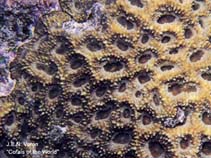Acanthastrea brevis Milne-Edwards & Haime, 1849
Starry cup coral| Native range | All suitable habitat | Point map | Year 2050 |

|
| This map was computer-generated and has not yet been reviewed. |
| Acanthastrea brevis AquaMaps Data sources: GBIF OBIS |
Классификация / Names народные названия | синонимы | CoL | ITIS | WoRMS
Hexacorallia | Scleractinia | Lobophylliidae
Environment: milieu / climate zone / пределы глубины / distribution range экология
ассоциированный с рифами; пределы глубины 1 - 20 m (ссылка 98471). Tropical; 30°N - 25°S, 35°E - 155°E (ссылка 848)
Distribution страны | регионы FAO | Ecosystems | места находок | интродукции
Indo-West Pacific: East Africa including Red Sea to Guam, north to Philippines and south to Indonesia.
Length at first maturity / Size / Weight / Возраст
половая зрелость: Lm ? range ? - ? cm
Краткое описание морфология
Life cycle and mating behavior половая зрелость | размножение | нерест | Eggs | Fecundity | Larvae
Основная ссылка
ссылки | координатор | соавторы
Scaps, P., V. Denis, S. Berhimpon and F. Runtukahu 2007 Zooxanthellate scleractinian corals of the northern coast of Sulawesi. Atoll Research Bulletin 553:1-21. (ссылка 83552)
Статус Красного Списка МСОП
(ссылка 130435: Version 2025-1)
Статус СИТЕС (ссылка 108899)
CMS (ссылка 116361)
Угроза для людей
Использование человеком
| FishSource |
инструменты
дополнительная информация
состав пищи
потребление пищи
хищники
Max. ages / sizes
Length-weight rel.
Length-length rel.
Размерный состав
Mass conversion
численность
ресурсы в Интернет
BHL | BOLD Systems | CISTI | DiscoverLife | FAO(Publication : search) | Fishipedia | GenBank (Геном, Нуклеотид) | GloBI | Gomexsi | Google Books | Google Scholar | Google | PubMed | Tree of Life | Wikipedia (Вперёд, поиск) | Zoological Record



